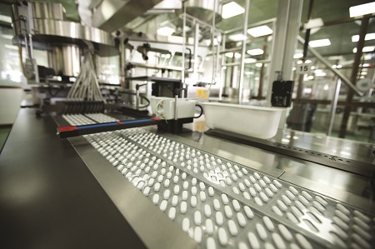Improving Pharma Packaging Line Efficiency Through Overall Equipment Effectiveness (OEE)
By Valerio De Simone, Ph.D., Adept Packaging

The pharmaceutical industry has benefited from high margins and low competition for decades. While the vast majority of engineering effort is directed toward compliance with new regulations and industry best practices, operational efficiency often remains a lower priority item for packaging departments in the life sciences industry. Over the past few years, the packaging area experienced unprecedented changes, moving from a pure logistic function to a fully digitized and validated environment. Among other drivers, serialization and track and trace regulations are probably the best examples of how compliance-driven projects have changed the pharmaceutical packaging world. Unfortunately, most of these changes resulted in a widespread loss of efficiency due to a variety of causes (e.g., new reject reasons, new IT and automation failures, new quality controls, etc.).
As a result, we are observing a general shift in the focus of the pharmaceutical industry. After years spent focused on compliance with new regulations, many major players are now investing in recovering the efficiency from their packaging lines. Fortunately, the technology that is now commonly available in the packaging area can be exploited far beyond mere compliance. Supply chain visibility, predictive maintenance, Big Data, and OEE live tracking are now becoming increasingly pertinent in pharma.
This article focuses on efficiency initiatives, providing some insights on how to better use overall equipment effectiveness (OEE) tracking systems and how to avoid common mistakes.
OEE: The Best Key Performance Indicator For A Packaging Line
Before starting any performance improvement project, the first step is to clearly define a performance indicator. Despite its wide adoption, there is not a univocal definition of OEE. From a helicopter perspective, we can say that OEE is fundamentally a comparison of times:
- The loading time represents the amount of time the machine should work, i.e., the planned production time. It is computed by subtracting the scheduled stops (planned downtime) from the calendar time.
- The operating time represents the time the machine actually works. It is computed by subtracting the unplanned stops (unplanned downtime) from the loading time.
- The net operating time represents the time the machine works at the standard production rate. It is computed by subtracting the minor stops and the speed losses from the operating time.
- The valuable operating time represents the time the machine releases good products at the standard production rate. It is computed by subtracting the time lost for quality reasons from the net operating time.
Comparing the valuable operating time and the loading time results in the OEE. As discussed above, the OEE measures how effectively a manufacturing unit (e.g., a machine) is utilized compared to its full potential. However, management is typically concerned with the performance of a packaging line as a whole. Unfortunately, there is not a ready-to-use formula for this: deriving the line OEE (also called OTE, overall throughput effectiveness) from the OEE of its machines is not a trivial task. In fact, it’s essential to take into account several aspects of the specific packaging line, such as:
- inter-operations buffers
- flow of reworks
- rejects management
- production speed
- maintenance policies
- standard operating procedures, etc.
The outcome of this analysis will be identification of the opportunities for efficiency gain, starting with the real production rate of the machine that determines the performance of the entire packaging line, i.e., the bottleneck.
OEE Tracking Systems
Ideally, an OEE tracking system should be able to measure the OEE of a packaging line and provide a clear indication to management on how it’s performing compared to a predefined target value. A company looking for such a solution has access to a very broad range of offerings. There are three types of solutions:
- Stand-alone – Dedicated sensors at the entrance and at the outfeed of the machine monitor the products’ flow, without any direct connection with the machine. This is typically used for old machines or to avoid any revalidation.
- I/O monitoring – A simple gateway collects a few output signals of the machine to monitor its running status, the rejects, and other relevant parameters. This is a valuable alternative to the stand-alone solution if the right signals are available.
- Embedded – The machine is natively able to monitor its OEE and send it to a superordinate system. This alternative is available only for very new machines.
Contrary to what we might think, the biggest challenge is not collecting this data, but rather extracting the valuable information from it. We often see complex systems made of sensors and interfaces for monitoring several or even all the machines in a packaging line, even though loss of efficiency from one machine will create a bottleneck limiting the rest of the line. Using a standard IT algorithm without considering the nuances of the specific packaging line results in an unreliable outcome. The tangible risk is to get a nice system showing live performance indicators that are not even close to what they should measure.
Accuracy Of OEE: Obtaining The Full Picture
Although the installation of an OEE tracking system is certainly a valuable step toward better visibility of the performance of the packaging lines, it is important to understand that the machines are just one part of a more complex system made up of operators, materials, methods, IT, and automation infrastructures. OEE losses might arise from any of these sources and could be invisible to an automated system.
For several historical and economic reasons, the pharmaceutical industry is far from being optimized for manufacturing effectiveness. As companies move toward increasing their efficiency, it is possible to learn from other industries where best practices are already commonly adopted.
In our experience, most companies are unaware of many daily losses affecting the packaging lines. Before starting any improvement project, the first step should be a holistic assessment to identify and rank the causes of performance loss, ideally through an OEE tracking system. Such an assessment should incorporate analysis of data and procedures, time spent in front of the packaging lines to understand the real operations (Gemba approach), and interviews with operators, maintainers, and management. The result is an exhaustive picture of the current status of the packaging line(s) from which management can prioritize the improvement actions.
About The Author:
 Valerio De Simone is a manager at Adept Packaging, which provides packaging consultancy services ranging from packaging development management to track and trace implementation. He spent the last five years serving the pharmaceutical industry for several internal projects, all related to the packaging area. His main fields of expertise are serialization and track & trace, business process analysis and optimization, lean manufacturing, and OEE. He holds a Ph.D. in Operations Management from Tor Vergata University of Rome. If you have questions or would like to learn more about OEE, contact Valerio at valerio.desimone@adeptpackaging.com.
Valerio De Simone is a manager at Adept Packaging, which provides packaging consultancy services ranging from packaging development management to track and trace implementation. He spent the last five years serving the pharmaceutical industry for several internal projects, all related to the packaging area. His main fields of expertise are serialization and track & trace, business process analysis and optimization, lean manufacturing, and OEE. He holds a Ph.D. in Operations Management from Tor Vergata University of Rome. If you have questions or would like to learn more about OEE, contact Valerio at valerio.desimone@adeptpackaging.com.
